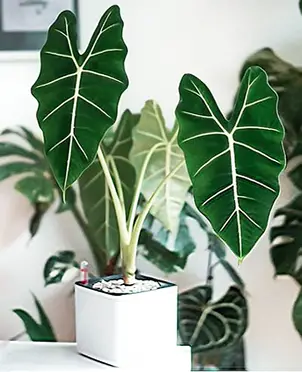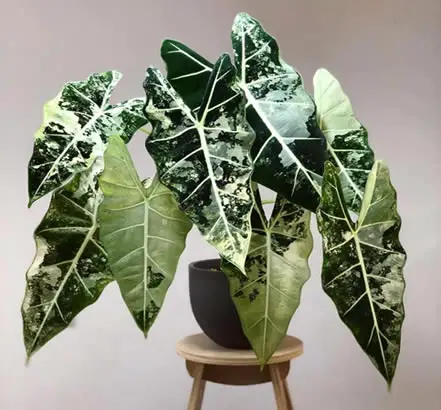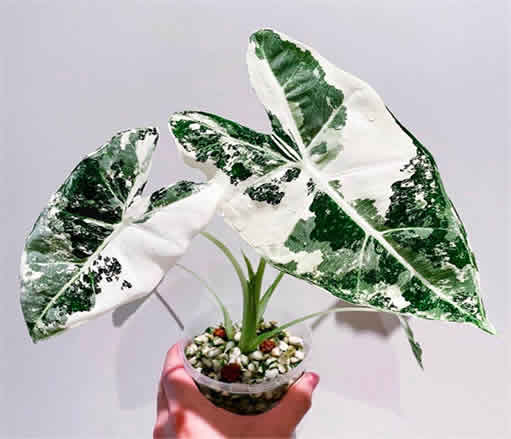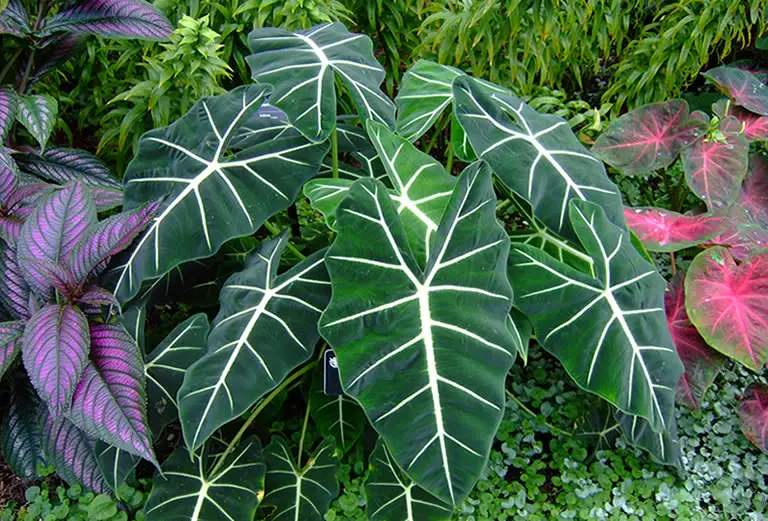Alocasia micholitziana ‘Frydek’—better known as the Green Velvet Alocasia—is a total showstopper with its velvety, deep green leaves and contrasting white veins. This plant has captured the hearts of plant lovers everywhere, but it definitely comes with a diva streak. Don’t worry though—with a little know-how, you can keep this tropical beauty happy and healthy.
Let’s dive into everything you need to know to care for your Alocasia Frydek like a pro.
Table of Contents
- What Alocasia Frydek Needs to Stay Happy
- Providing the Right Kind of Light
- Watering Alocasia Frydek Without Overdoing It
- Picking the Perfect Soil Mix
- Temperature Tips: Keep Things Warm and Cozy
- Feeding Frydek: When and How to Fertilize
- Humidity: The Secret to That Signature Glow
- Pruning: Keep It Clean, Not Overdone
- Propagation by Division: Multiply the Velvet
- Repotting Frydek the Right Way
- Keeping an Eye on Pests and Diseases
- Toxicity Warning: Not Pet- or Kid-Safe
- Common Frydek Issues and What to Do
What Alocasia Frydek Needs to Stay Happy
Scientific Name: Alocasia micholitziana ‘Frydek’
Common Name: Green Velvet Alocasia
Origin: The Philippines
Light: Bright, indirect light—avoid harsh direct rays
Watering: Water when the top 1–2 inches of soil feel dry
Soil: Well-draining, rich mix (try 60% peat, 30% perlite, 10% compost or worm castings)
Temperature: 65–85°F (18–29°C); avoid temps below 60°F (16°C)
Humidity: Above 50% is ideal
Fertilizer: Monthly during the growing season with a diluted balanced feed
Propagation: Best done by division in spring or early summer
Toxicity: Toxic to pets and humans if ingested
Providing the Right Kind of Light
Frydek loves bright, indirect light—but direct sunlight can burn those gorgeous leaves.

A spot near a window with filtered light or a sheer curtain works wonders.
If it’s too dark, your plant might grow painfully slow, and lower leaves may yellow and drop.
Too much sun? You’ll see crispy tips and scorched edges.
Pro tip: Keep your plant rotated every week or two so it grows evenly instead of leaning toward the light.
Watering Alocasia Frydek Without Overdoing It
Alocasias are picky about their watering routine. They don’t like to dry out completely, but they also hate soggy roots.
During the growing season, wait until the top inch or two of soil dries out, then water thoroughly and let it drain fully.
Avoid leaving it sitting in water, and never water on a strict schedule—go by what the plant and soil are telling you.
Come winter, growth slows down or stops completely.
You may need to switch to “sip watering”—small amounts just to keep the roots from drying out, rather than full soakings.
Picking the Perfect Soil Mix
Great Frydek care starts with the soil.
You want a mix that drains fast but still holds a little moisture.
A blend of 60% peat, 30% perlite, and 10% compost or worm castings works beautifully.
If you’re avoiding peat, coco coir is a sustainable alternative that works just as well.
Avoid heavy, compacted soils that hold too much water—this is a fast track to root rot.
Temperature Tips: Keep Things Warm and Cozy
Think tropical—because that’s what Frydek wants. Ideal temps range between 65–85°F (18–29°C).
Avoid cold drafts or sudden shifts in temperature, which can lead to yellowing, drooping, or leaf loss.
Anything below 60°F (16°C) might trigger dormancy.
Keep it away from heaters, AC vents, and drafty windows.
If you notice signs of stress, check its environment for sneaky temperature dips.
Feeding Frydek: When and How to Fertilize
This plant loves a little extra food when it’s actively growing.
Use a balanced water-soluble fertilizer diluted to half strength once a month during spring and summer.
Too much fertilizer can cause root damage and yellow leaf tips, so less is more.
Organic options like compost or worm castings can be great too—just be careful not to overdo it.
Whatever you use, avoid fertilizing in winter when the plant slows down.
Humidity: The Secret to That Signature Glow
Alocasia Frydek really thrives when humidity is high—aim for 50% or more.

In drier homes, you might notice crispy edges or browning tips.
To bump up the moisture:
-
Use a humidifier
-
Place your plant on a pebble tray with water
-
Cluster it with other humidity-loving plants
-
Move it to a steamy bathroom (with light!)
Keep an inexpensive digital hygrometer nearby so you can monitor humidity with ease.
Pruning: Keep It Clean, Not Overdone
Frydek doesn’t need heavy pruning.
Just remove any yellowing or crispy leaves as they appear.
Use sterile scissors or pruning shears and cut at the base of the leaf stem.
That’s it—easy!
Propagation by Division: Multiply the Velvet
The best way to propagate Alocasia Frydek is by dividing a mature plant in spring or early summer. Here’s how:
-
Gently unpot the plant and shake off excess soil.
-
Identify natural clumps or offshoots in the rhizome.
-
Use your fingers or a clean blade to divide, ensuring each piece has roots.
-
Plant divisions in fresh, moist soil and keep in a warm, bright spot.
-
Mist gently and monitor humidity.
It’s a slow process, but super rewarding.
Repotting Frydek the Right Way
Alocasias like being slightly root-bound, so only repot when roots start growing out of the drainage holes or the plant seems to be struggling.

Go up just one pot size, and only repot in spring if possible.
After repotting, water lightly for the first week or two to help it adjust.
Keeping an Eye on Pests and Diseases
Unfortunately, Frydek is a magnet for sap-suckers like spider mites, thrips, and mealybugs.
Check under leaves and along stems regularly, and treat with insecticidal soap or neem oil at the first sign of trouble.
Also, root rot is a major risk if overwatered—so always make sure the soil drains well and the pot has drainage holes.
Toxicity Warning: Not Pet- or Kid-Safe
Alocasia Frydek is toxic if ingested, causing irritation or swelling.
It can also cause skin irritation for some people.
Keep it out of reach of curious pets and children, and wear gloves when handling if you’re sensitive.
Common Frydek Issues and What to Do
Why is my Alocasia Frydek drooping?
Check for watering issues first—too much or too little are both common culprits.
Temperature dips, stress from repotting, pests, or nutrient imbalance can also cause drooping.
Why are the leaves turning yellow?
Usually, it’s a sign of overwatering.
But it can also come from too much direct sun, drafts, or nutrient issues.
Always check your soil and environment first.
Related Articles
You may be interested in these other articles about Alocasia care:
Alocasia Plant Care: Indoor & Outdoor Care Guide
Alocasia Water Guide. Watering Alocasia & Growing Alocasia In Water
Understanding Alocasia Dormancy: What It Is, Why It Happens, and How to Handle It
Alocasia Dragon Scale Care Guide: How to Keep This Jewel Alocasia Thriving
Why Are My Alocasia Leaves Turning Yellow? Causes, Fixes, and What to Do Next
Why Is My Alocasia Drooping? Common Causes and How to Revive It
How to Keep Your Alocasia Wentii Thriving: Complete Care Guide

